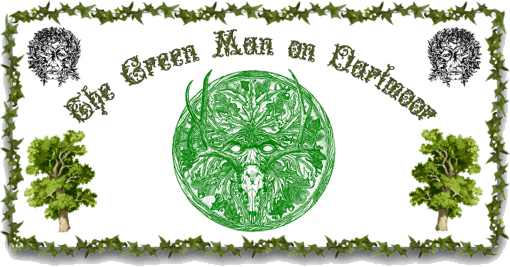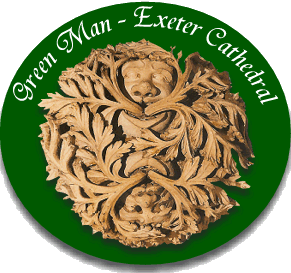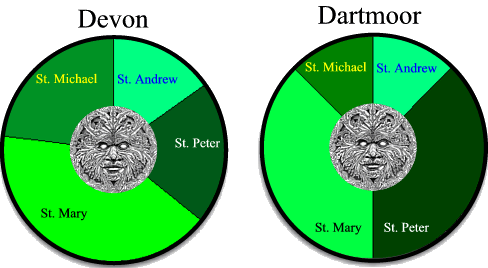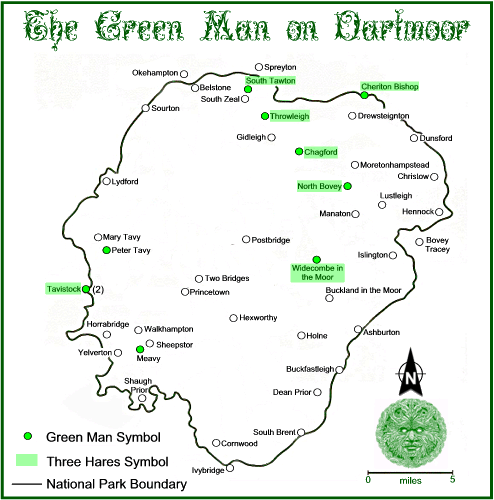
The ‘Green Man’ phenomenon seems to have become a popular subject over the past twenty years or so and Dartmoor supports its fair share of related symbols. The subject was first raised in the 1930’s and in 1939 Lady Raglan wrote the following when discussing a foliate head carving at Llangwm church, Doel, 2001, p.15:
“It seemed to me certain that it was a man and not a spirit and moreover that it was a ‘Green Man’. So I named it… This figure is neither a figment of the imagination nor a symbol, but is taken from real life, and the question is whether there was any figure in real life from which it could have been taken. The answer, I think, is that there is only one of sufficient importance, the figure variously known as the Green Man, Jack in the Green, Robin Hood, The King of May, and the Garland, who is the central figure in the May-Day celebrations throughout Northern and Central Europe.“
This gave birth to the term ‘Green Man’ which is now used to describe various figures but broadly speaking it describes a head disgorging vegetation from its eyes, nostrils, ears, or forehead, or a foliate head where the cheeks are depicted as leaf like, Doel, pp. 17 – 18.

A Green Man Boss
The comedian, Mike Harding has an interest in the Green Man and on his website he nicely groups the varying figure designs into four categories:
Foliate – the head turning into leaves
Spewing or Uttering – branches and leaves coming from the mouth
Jack In The Green – the face appearing on a bower of leaves
Sucker – branches coming from the eyes ears and nose
Nationally, by far the most common type of design is the ‘Spewer’ as it accounts for about 70% of known figures.
There are many theories about what the Green Man represents and they would make an entire website of their own but basically there are two schools of thought. Firstly, Basford, considers that the Green Man is the most common decorative motif to be found in Medieval church sculpture. She also states that its origins lay in the artistic memorials found in the Roman art of the first century AD. On the other hand, Anderson divides the origins into two forms, the mask form of the symbol he likewise attributes to the first century Romans. But the other types he dates back to Celtic times which have developed from the head cults of the Iron Age. These theories are only applicable to British symbols, it is thought that on a global scale they could date back at least 4,000 years and can be found on many continents.
The general belief is that the Green Man acts as a symbol of renewal and rebirth, hence its connections with May Day and Jack-in-the Green. As to why it should be used in church architecture is a mystery, certainly in Britain the symbol only started to appear from the late Norman period.
Anderson suggests that the recent upsurge in the interest in the Green Man is because:
“An archetype such as the Green Man represents will recur at different places and times independently of traceable lines of transmission because it is part of the permanent possession of mankind. In Jung’s theory of compensation, an archetype will reappear in a new form to redress imbalance in society at a particular time when it is needed. According to this theory, therefore, the Green Man is rising up into our presence awareness in order to counterbalance a lack in our attitude to Nature,” pp. 17,25.
Could this idea have applied to the Green Man’s inception? Certainly the earliest forms that date back to Neolithic times would co-inside with a prolific period of land clearance, as would the later 14th – 16th century examples
On Dartmoor, the earliest example of the Green Man is probably at South Tawton which is said to date from the 14th or 15th centuries. Apart from those at Castle Drogo, all the known occurrences are to be found in churches or abbey ruins. The majority of them are carved roof bosses or capitals, however some of them do appear on screens, benches, and pulpits.
It is interesting to note the correlation between the churches where the Green Man symbols are found and their actual dedications. Nationally there are by far more Green Men found in churches dedicated to St. Mary, then All Saints, Peter, and Andrew. Devon to some degree reflects this trend but Dartmoor has an equal number of Green Men and dedications to St. Mary and St. Peter as can be seen from the pie-charts below:

This correlation between the church, its saint, and the Green Man, stems from an idea that if the Green Man was associated with Robin Hood, then the Virgin Mary could be his Maid Marion, hence the reason for so many symbols being found in churches dedicated to St. Mary. But this idea falls a bit short when one looks at the number of churches that were re-dedicated to St. Mary after the supposed date of the Green Man.
There are 9 known Green Man locations that can be found on Dartmoor, the total number of known figure locations in Devon is 87. These figures only include the town or village and some of these locations will have more than one instance of a green man, i.e. Tavistock.
| Location |
Church |
Position |
| Castle Drogo |
– |
used in interior design motifs by Lutyens |
| Chagford | St. Michael | Nave, north & south aisle |
| Cheriton Bishop | St. Mary | On the pulpit |
| Meavy | St. Peter | Roof boss |
| North Bovey | St. John | Chancel bosses, bench end |
| Peter Tavy | St. Mary | South transept, west wall, screen |
| South Tawton | St. Andrew | Bosses |
| Tavistock Abbey |
– |
West side of abbey ruins |
| Tavistock | St. Peter | Stair & exterior – capitals, bosses |
| Throwleigh | St. Mary | North aisle – bosses |
| Widecombe-in-the-Moor | St. Pancras | Chancel, north aisle – bosses, timber |
Sadly as yet I have not got any decent photos of Dartmoor’s Green Men as I have not got a zoom or a flash strong enough to capture them as they hide high up in the dusty roofs.
When the Green Man locations are plotted on a map of Dartmoor, two things become startlingly clear; firstly that they are clustered around the old tin mining areas of the moor and secondly with the exception of Meavy and Peter Tavy they occur alongside symbols of the Three Hares as can be seen below:

Again, the exact meaning of the Three Hares is as much a mystery as the Green Man but where they occur together is by and large a unique feature to Devon. Should you wish to go in search of the Green Men of Dartmoor it is advisable to take a strong torch, a camera with a long zoom, and a can of Ralgex. The latter you will need to soothe the aching neck you have acquired from prolonged periods of looking directly upwards. Many of the bosses are located in the dark roof recesses of the churches and in some cases will take some finding.
There is also another category that can be added to the Green Man phenomenon and that is the ‘Foliate Skull’. This design is thought to have arisen after the Black Death and is meant to portray the more gruesome side of death. On Dartmoor there are two such heads, one at South Tawton and another at Sheepstor.
Reading List.
Anderson, W. 1990 Green Man, Harper Collins, London.
Basford, K, 1998 The Green Man, D. S. Brewer, Woodbridge.
Doel, F. & G. 2001 The Green Man in Britain, Tempus Pub., Stroud.
Harte, J. 2001 The Green Man, Pitkin, Andover.
Hicks, C. 2000 The Green Man – A Field Guide, Compass Books, Fakenham.
Matthews, J. 2002 The Green Man – Spirit of Nature, Connection Book Publishing.
Matthews, J. 2001 The Quest for the Green Man, David & Charles, Newton Abbot.
Millar, R. 1997 The Green Man – Companion & Gazetteer, S. B. Pub. Seaford.
Pevsner, N. 1952, The Buildings of England – South Devon, Penguin, Harmondsworth.
 Legendary Dartmoor The many aspects past and present of Dartmoor
Legendary Dartmoor The many aspects past and present of Dartmoor

Hi Tim,
Great website and article. After a recent visit I’ve managed to expand our online photographic archive of green men on Dartmoor considerably. Please do feel free to visit our website at http://www.thecompanyofthegreenman.co.uk and click through to our Flickr archive. If there are ever any photos you would like to use for your website please just shout. My zoom, flash and trusty high powered torch paid dividends but cricked neck syndrome was still unavoidable.
Hello Tim,
Brilliant legendary Dartmoor articles and lovely photographs, I’m from the I.O.W, but I have many ancestors down your way not just the many farmers and stonemasons who carved the green man and maybe that cross you’re pictured leaning on. But I have links to the great artist JMW Turner, sailor Francis Drake and author Beatrice Chase to name but a few. I also do Celtic drawings, watch Clint Eastwood films, play the blues harmonica and walk the dog. Best Wishes.